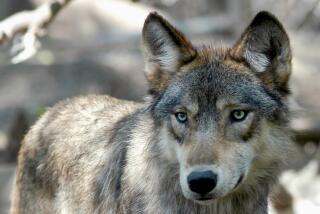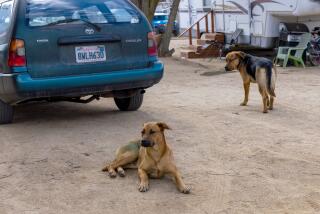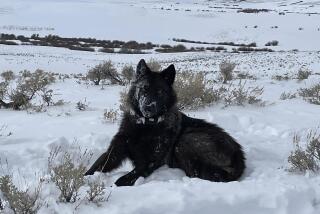Trapper lures wolves from Denali, kills 2; pack’s future in doubt
The two primary breeding females from the best-known wolf pack at Denali National Park — a pack viewed by tens of thousands of visitors each year — have been killed, one of them by a trapper operating just outside the boundary of Alaska’s premier national park.
The incident has raised an outcry among Alaska conservationists. They’re demanding an immediate halt to wolf trapping in what was formerly a buffer zone northeast of the park, an area made famous as the scene of the abandoned school bus in Jon Krakauer’s “Into the Wild.”
The trapper apparently shot an aging horse and left it as a lure for the wolves, according to residents in the area. Park officials, who have unsuccessfully sought to maintain a no-hunting buffer alongside the park, said two wolves, at least one of them from the well-known Grant Creek pack, were fatally snared near the carcass.
One of the dead wolves was equipped with a radio collar attached by scientists; it was the only female from the pack known to have raised pups last year. The pack’s only other known breeding female was found dead near the pack’s den, probably of natural causes. A third wolf, also snared near the horse carcass, was a male that may or may not have been part of the Grant Creek pack, said Tom Meier, wildlife biologist for Denali National Park.
“It’s always disappointing to lose animals that close to the park boundary, and it also was disappointing because it was inside what used to be … the buffer zone,” Meier told the Los Angeles Times.
Rick Steiner, an independent wildlife conservation biologist and former professor at the University of Alaska, has petitioned the state commissioner of fish and game for an emergency closure of the former buffer area northeast of the park to allow the pack to regroup.
The loss of the pack’s two primary breeding females could result in the dissipation of one of the park’s most visible wolf packs, Steiner and others said.
“This is one of the most highly valuable, highly viewed wolf packs, not just in Alaska or the nation, but the world. And now they will not have pups this year, almost certainly,” Steiner said in an interview.
“What we know is if they don’t have pups, sometimes the packs simply disintegrate. This has happened before. And it’s all because of the state prioritizing the rights of these one or two trappers over the rights of hundreds of thousands of park visitors.”
Steiner said he was told that the bait was an aging horse already on the verge of death. It was not clear whether the trapper shot the horse at the scene of the snare or transported it by snowmobile to the location. It did not appear that any laws were broken, officials said.
The state-owned areas just outside Denali — and in this case, an area known as Stampede Trail that extends as a finger inside the park — have long been subject to controversy over hunting and trapping because of their proximity to the park, where animals are protected.
Conservationists succeeded in persuading the Alaska Board of Game to establish a no-hunting buffer zone in the region in 2002.
The National Park Service, which had initially been neutral on the issue, decided that wolves at Denali were in enough danger that the agency in 2010 joined conservationists in seeking to extend and even expand the buffer zone.
Instead, the Board of Game later eliminated the buffer zone, leaving hunters and trappers to operate on state lands up to the boundaries of the park — boundaries that are fairly arbitrary for wildlife moving in and out of the park.
The wolf population at the 6-million-acre park is at a 20-year low -- just 70 wolves in nine packs — down from 103 wolves in 15 packs as recently as 2006, Meier said.
He said biologists are unsure what has caused the declines, but they worry about the loss of the top two breeding females in a pack such as Grant Creek.
The collared female caught in the snare had been part of a study, still under way, to determine whether closing the buffer zone would affect the population of the wolf packs most important to park tourists, Meier said. “This is certainly an important piece of information,” he said of the incident.
The state Department of Fish and Game did not immediately say whether it would act on Steiner’s request for an emergency closure.
The horse carcass was found about a mile outside the park boundary, officials said, where it continues to inflict misery. David Braun, who has a recreational cabin in the area, said he discovered the horse lying in a small stream near his cabin; this year, that stream feeds into his water supply.
He already has fought off an intestinal illness, he said, though the family is taking precautions. “We’re boiling the water,” he said.
ALSO:
Supreme Court: In vitro children might not be due benefits
Tennessee man dubbed ‘Octodad’: Questions and more questionsHome of the Braves no more: Oregon bans Native American mascots
kim.murphy@latimes.com
More to Read
Sign up for Essential California
The most important California stories and recommendations in your inbox every morning.
You may occasionally receive promotional content from the Los Angeles Times.










